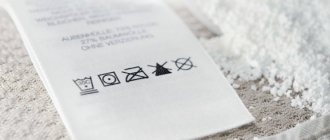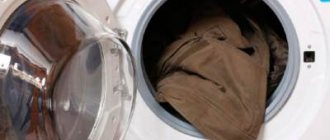Washing tulle requires certain knowledge and skills. To make transparent fabric snow-white without harming it, you can use salt.
With her help, our great-grandmothers and grandmothers washed tulle, since getting any bleaching agent in those days was problematic.
Nowadays, salt is rarely used as a cleaning agent, although it helps to carefully and efficiently remove most contaminants.
How to wash tulle with salt in a washing machine and by hand so that it is white? Details are in the article.
How to bleach tulle with salt and soda
If it seems to you that the color of the daytime curtains is no longer as white as you would like, try bleaching the tulle with salt and soda.
You will need boiling water - 7-10 liters, 200 grams of salt, 2 heaped tablespoons of soda and a good portion of washing powder - approximately 150-200 grams. Dissolve all dry ingredients in boiling water, wait until it cools enough to hold your hand in it. Dip the tulle into the bleaching solution, stir and leave for 6 hours.
Afterwards, the fabric must be wrung out, rinsed thoroughly and dried. If the curtain is heavily soiled, after soaking it should be washed in the washing machine on the “wash delicate fabrics” setting.
Table of temperature conditions for washing tulle from different materials
| Fabric type | Temperature, °C | Recommendations |
| Organza | 30–35 | Hand wash preferred. If in the car, use delicate mode. Do not squeeze. Do not rub during washing |
| Polyester | 45–60 | In the washing machine (standard mode) or by hand |
| Veil | no more than 30 | Manually or use delicate mode |
| Capron | up to 45 | In the car in standard mode |
| Kiseya | 30–35 | Wash only in the cover. Do not squeeze. Hang and straighten to dry. Hang it on the window when damp. |
Salt bleaching
Baking soda has a whitening effect, and salt enhances it even more. But not all types of tulle can be bleached with salt. Chemical formula – NaHl. It contains chlorine, so some tissues are afraid of salt:
- nylon;
- nylon;
- organza;
- jacquard;
- natural silk and others
Do not immerse in saline solution for a long time. The fibers may break down and the fabric may shrink or become deformed.
IMPORTANT: When soaking in bleach, only enamel or plastic dishes can be used.
Causes of yellowing tulle
The main reasons for changes in the color of tulle fabric are:
- influence of dust and grease;
- street soot and gases;
- washing without soaking and removing dust particles;
- use of hot water, more than 40°C, for artificial fabrics;
- tobacco smoke;
- exposure to sunlight on fabric.
To maintain the presentable appearance of tulle for a long time, it is necessary to properly care for it. It is recommended to wash tulle at least once every 3-5 months, depending on how dirty it is. Bleaching methods depend on the material from which they are made and what type of contamination is present on the fabric.
Tulle can be made from various materials:
- artificial - nylon, nylon, polyester;
- natural - these include linen, cotton, silk.
They differ in the type of weaving - mesh, organza, muslin or veil.
- Organza is a popular type of fabric. This fabric is made by twisting fibers from silk, viscose or polyester. The lightweight fabric is distinguished by its quality: it drapes, forming voluminous folds, and holds its given shape, is practically not subject to wear and detains the sun's rays. Tulle made from this type of material is the most popular.
- The grid speaks for itself. The fabric has a mesh structure that allows air and light to pass through. This type of fabric is most susceptible to collecting dust, so it is not suitable for people with allergies.
- A veil is a translucent fabric that allows light and air to pass through. A thin veil is made from silk, cotton and even wool threads. Has the property of repelling dust.
- Kisey is a special type of tulle. Consists of woven threads or strands of silk, synthetics or cotton, fastened together. Beads, glass beads, and seed beads are woven into the threads. This type of tulle does not need frequent washing.
Using table salt
Our grandmothers knew how to bleach tulle at home. They always added plain table salt when soaking white laundry. Therefore, the curtains made of linen and cotton in their house were always snow-white.
For soaking, take salt at the rate of 100 g per liter of water. Soak the fabric in a strong saline solution for several hours. The bleached tulle is then hand washed with laundry soap or hand wash detergent.
Afterwards, the curtain is rinsed, but not wrung out too much, and dried in a straightened state. Many people note that tulle in a saline solution begins to turn white literally before their eyes.
Washing features
Washing tulle in salt allows you to cope with several tasks at once. It not only perfectly pushes dirt out of fabric fibers, but also bleaches it. Thanks to this washing, the curtains will not come apart, holes and scuffs will not appear on them.
The undoubted advantage of the method is its low cost, accessibility and safety . Salt is sold in all grocery stores. For one wash you will need no more than 5-8 tablespoons. The solution is prepared at the rate of 1 tbsp. l. salt per 1 liter of water.
It does not cause an allergic reaction and does not require respiratory protection during washing. Even if salt particles remain in the fibers of the fabric, it will not turn yellow under the influence of sunlight. When heated, salt does not release harmful fumes into the air.
It is used in several ways:
- For soaking before washing the product. Then the curtains are treated with other detergents.
- For washing. No further actions are required.
- For bleaching after washing. First, the tulle is cleaned in a washing solution and then soaked in salt.
General guidelines for action:
- Remove the tulle and shake it thoroughly to get rid of dust. It is best to do this on the balcony or outside.
- Additionally, you can rinse the product under running water.
- Wash the tulle in a soda solution. Hand and machine wash methods are described below.
- Hang the product out to dry.
To enhance the bleaching effect, brilliant green is added to the saline solution, soda is used to increase cleaning properties, and vinegar is used to remove foreign odors.
In the washing machine
Salt can be used as a cleaning agent by pouring it into the washing machine compartment.
The algorithm of actions is as follows:
A tablespoon of salt is poured into the powder tray. A packet of baking powder for the dough is also added there. It is used to prevent scale from forming on the heating element.- Shake off the dust from the tulle, carefully fold it and place it in the drum of the washing machine.
- Turn on the delicate wash mode. The water temperature should not exceed 30-40 degrees, and the rpm speed should not exceed 400. Sometimes the spin cycle is turned off.
- After washing is completed, the product is removed from the drum and hung out to dry.
To save time, the curtains can be loaded into the drum of the washing machine along with the hooks.
In this case, you need to use a laundry bag. If any hooks become unhooked, they will remain inside the mesh and will not lead to damage to household appliances.
Manually
Washing tulle with salt by hand is easy. Method for preparing the cleaning solution:
- 4 tablespoons salt;
- 4 liters of warm water;
- salt is poured into water and mixed thoroughly until it is completely dissolved.
Salt dissolves better in hot water. Therefore, you can dilute it in boiling water and start washing after the solution has cooled. The recommended water temperature is 30-40 degrees.
When the cleaning solution is ready, you can begin the washing process. It includes the following steps:
- Place the tulle in the basin so that the water completely covers it.
- Leave the product for 5-8 hours. This is enough for the salt to dissolve all dirt and bleach the fabric.
- After the specified time, the tulle is rinsed in clean, cool water.
Alternatively, you can wash the item using any other detergent and then rinse it in a saline solution. This treatment prevents the fabric from turning yellow.
With vinegar to make it white
You can wash tulle in a solution of salt and vinegar. To prepare it you will need the following components:
- 5 tablespoons of salt;
- 5 tablespoons of vinegar with a concentration of 9%;
- 5 liters of warm water.
All components are thoroughly mixed. In the finished composition, the tulle is soaked for an hour, after which it is rinsed and sent to dry. This method will not only whiten the product, but also remove persistent odors from the fabric.
With brilliant green
To enhance the whitening effect, you can use brilliant green. To prepare the detergent composition you will need the following components:
- 5-8 drops of brilliant green;
- 5 liters of warm water;
- 5 tablespoons of salt.
In order for the solution to bleach the fabric and not give it a turquoise tint, it must be allowed to settle. After 5 minutes you need to look at the bottom of the pelvis.
If there is a green precipitate, the solution is mixed again, or carefully, without shaking, poured into another suitable container. The sediment should remain in the first basin.
Further actions are as follows:
- Soak the tulle in the solution.
- Leave for 10 minutes.
- Gently wring out the product, do not rinse it.
- Dry the tulle.
Since the product is not rinsed, this method is not suitable for removing dirt, but for whitening it. If the curtain is dusty, then it must first be washed using detergents.
With soda
If the curtains have been hanging in the kitchen for a long time, then a soda-salt solution will help deal with soot and yellow deposits.
You need to proceed as follows:
- dilute 5 tablespoons of salt and 3 tablespoons of soda in 5 liters of warm water;
- soak the tulle in the resulting solution;
- leave the product for an hour;
- Rinse the fabric thoroughly and leave to dry.
If it was not possible to get rid of yellowness the first time, the procedure can be repeated. In this case, the solution is strengthened with hydrogen peroxide (2 teaspoons are required for 5 liters of water). Soaking time is reduced to 30 minutes.
The video will show you how to wash tulle with soda:
Soda and vinegar at the same time
If the tulle of the curtains is stained, and this can often happen in the kitchen, use soda and vinegar.
For pronounced stains, proceed as follows. The curtain is soaked in water. The most contaminated areas are sprinkled with soda and distributed over the surface. Then 9% or 7% table vinegar is poured directly onto the stain.
Afterwards the fabric is left for 2-3 hours. It is then rinsed, washed and dried as usual. With this treatment, the stains will dissolve and your curtain will become white again.
Washing tulle with salt in the washing machine
If there is no time for soaking, and a large amount of dust and dirt has accumulated on the tulle, then you have to wash it in a machine. And in this case, table salt also comes to the rescue. A tablespoon of this product is poured into the powder compartment and 1 packet of baking powder is added.
The tulle is shaken from dust, carefully rolled up and placed in the drum of the washing machine. The curtain is washed in a gentle wash mode with a water temperature of no more than 30° C. It is better to refuse spinning or set the minimum number of revolutions, which should not exceed 400 rpm.
How to bleach synthetic tulle
With synthetic fabric, as we have already said, you need to be especially careful. Reduce the amount of salt by 2-3 times, use not hot water, but lukewarm water (+30C).
The whitening effect will be enhanced by a few drops of brilliant green - ordinary brilliant green or crystals of potassium permanganate, literally on the tip of a knife. To prevent the fabric from staining, you must first stir the composition well in the liquid, and then immerse the fabric in it. After this treatment it will be snow-white.
Important Tips
- Before you start washing, you must read the manufacturers' recommendations indicated on the product tag. You should not neglect these rules, otherwise, after the first wash, the tulle may stretch and lose its attractiveness.
- If you don't have special detergents for particularly delicate materials in your home, you can use regular mild shampoo.
- For hand or machine washing, use only rock salt, not “extra salt.” Also, you should not wash curtains with iodized salt.
- After washing, do not twist or wring out the tulle, but only lightly shake off the water and hang it in a well-ventilated place. It is important to ensure that the product is not exposed to bright ultraviolet rays; this can leave unsightly yellow stains on the tulle. Under their own weight, the curtains straighten. If necessary, after drying, you can iron the tulle with a warm iron.
How to restore whiteness with salt, peroxide and ammonia
Watch from 1 min 40 sec.
If the tulle has a yellowish or gray tint, this may be caused by people smoking indoors, opening windows, and soot and dust flying from the street, or often cooking something on the stove.
In this case, the effect must be enhanced with peroxide. You will need 2 standard bottles (200 ml) of hydrogen peroxide 3% concentration and 50 g of salt. They need to be dissolved in 5 liters of hot water (t +50C). Peroxide can be replaced with ammonia, but you will need less of it - 100 ml. You need to soak the tulle for 12 hours, it is better to do it overnight. Then wash and dry as usual.
Here's how to bleach tulle yourself without harsh chemicals, without going to the dry cleaner. Let the curtains in your home delight you with sparkling cleanliness and pristine freshness.
Soaking tulle in saline solution
The use of table salt as a bleaching agent for window curtains is still relevant today. The advantages of this substance are obvious:
If after washing with a regular detergent the tulle does not seem snow-white enough, then you can immediately soak it in a saline solution. To prepare it, you will need 5 liters of slightly warm water, in which you need to stir 4 tablespoons of salt. The tulle is placed in the solution for 15 minutes, after which it is removed and allowed to drain.
There is no need to rinse the curtain with clean water after soaking.
Useful tips for housewives
Among the lesser-known and popular tips for bleaching tulle are recommendations for boiling, but this method is not safe or reliable enough. It is much more important to thoroughly shake out the textiles before soaking so that accumulated dust is not absorbed into the fibers. Then softer substances, such as starch, can also make the curtains white.
First of all, the tulle must be carefully removed and shaken out on the street.
When bleaching, you should not pour too hot water, a maximum of 40 degrees is enough, optimally 30-35. Hot water will not help remove stains, but will “seal” the stains. Organza especially does not like hot water and chemical bleaches. Do not wrinkle the fabric when washing or twist it to avoid creating creases. After rinsing, you can simply hang the curtains and let the water drain.
Curtains made from delicate fabrics require careful handling.
To add shine to textiles, add a tablespoon of vinegar to the water when rinsing. Not only will it make the fabric shine, but it will also remove odors that have been absorbed into the curtains. Tulle does not require ironing. After the water has drained, the wet curtains are hung on the curtains. This way they will straighten themselves under their own weight, and you won’t have to wait for the curtains to dry.
Boiling the fabric
This is the easiest way to bleach tulle, requiring a minimum of cost from the housewife. Those who choose it are required to act like this:
- You should take a large saucepan, fill it with water and put a large amount of soap crumbs or soap into the water. You can use washing powder instead. You should wait until these components are completely dissolved in water.
- Next, you need to put the curtain itself in the same pan, which needs to be rid of grayness and yellow spots. It needs to be boiled for about an hour.
- After this, the fabric will need to be rinsed and dried.
Important: remember that this bleaching method is not suitable for all materials. Many synthetic fabrics deteriorate from such exposure.
Folk remedies for whitening tulle
Our mothers and grandmothers have come up with many ways to return curtains to their whiteness and new look. Here are some of them:
Zelenka. Don't be afraid of this method. The curtains won't turn green. Take a container with hot water and drop 4 to 10 drops of brilliant green into it. Dip the washed curtain into the resulting solution and keep it in this position for 3 hours. Then the tulle is rinsed and hung directly on the cornice. The fabric gets rid of its gray tint and begins to sparkle in the sun.
Whitening tulle with brilliant green: one of the oldest folk methods that has proven its effectiveness in practice
Potassium permanganate. This method of bleaching tulle is carried out in several stages:
- Dissolve one glass of grated white laundry soap in warm water;
- A small pinch of potassium permanganate is stirred in a glass of warm water until the crystals are completely dissolved;
- Pour potassium permanganate into a basin with 6 - 7 liters of soapy water. You should get a slightly pink liquid;
- Place tulle in the liquid and leave it there for 5 to 12 hours;
- Wash the curtain by hand and rinse thoroughly;
- Allow the water to drain and hang it on the cornice.
An interesting effect is obtained by using starch to whiten tulle and get rid of the gray tint. In addition to renewing the fabric, it creates a thin film on the surface and thus repels dirt. In this case, they act according to the following scheme:
- Mix a glass of potato starch with the same volume of water. Mix thoroughly so that there are no lumps;
- Pour the mixture into a basin with 5 - 6 liters. water;
- Tulle is placed in the liquid and kept there for 6 hours;
- Take out the curtain, squeeze it lightly, let the water drain and hang it in its designated place.
In addition to bleaching tulle, starch helps to further protect the fabric from contamination
Removing yellowness with salt
Salt can also remove yellow stains from curtains. You need to do it like this:
- First, you need to rinse the product well so that there is no dust left on it.
- After this, you should prepare a saline solution. To do this, you need to add regular washing powder to five liters of water (determine the amount based on the manufacturer’s recommendations) and 5 tablespoons of salt. It is recommended to leave the tulle in this solution overnight.
- In the morning, the product will need to be washed and rinsed well.
You can also use another method of washing curtains with table salt. The product should be washed as usual, then you should prepare a new saline solution with 4 tablespoons of salt and re-soak the product in it: this remedy will help completely rid the tulle of yellowness. After this, all you have to do is dry the product well without additional rinsing. This bleaching method is suitable for almost all fabrics.











